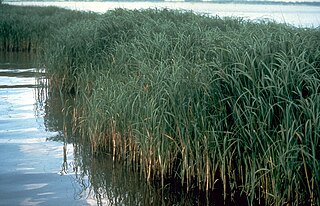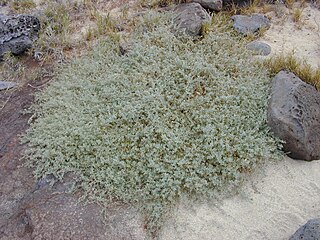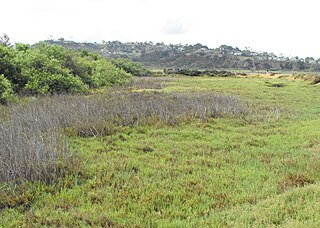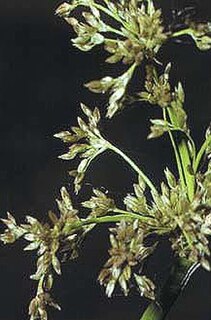
A halophyte is a salt-tolerant plant that grows in soil or waters of high salinity, coming into contact with saline water through its roots or by salt spray, such as in saline semi-deserts, mangrove swamps, marshes and sloughs and seashores. The word derives from Ancient Greek ἅλας (halas) 'salt' and φυτόν (phyton) 'plant'. Halophytes have different anatomy, physiology and biochemistry than glycophytes. An example of a halophyte is the salt marsh grass Spartina alterniflora. Relatively few plant species are halophytes—perhaps only 2% of all plant species. Information about many of the earth's halophytes can be found in the ehaloph database.

Juncus effusus, with the common names common rush or soft rush, is a perennial herbaceous flowering plant species in the rush family Juncaceae. In North America, the common name soft rush also refers to Juncus interior.

The Eastern Desert is the part of the Sahara desert that is located east of the Nile river. It spans 223,000 square kilometres (86,000 sq mi) of North-Eastern Africa and is bordered by the Nile river to the west and the Red Sea and Gulf of Suez to the east. It extends through Egypt, Eritrea, Sudan and Ethiopia. The Eastern Desert is also known as the Red Sea Hills. The Desert consists of a mountain range which runs parallel to the coast, wide sedimentary plateaus extending from either side of the mountains and the Red Sea coast. The rainfall, climate, vegetation and animal life sustained in the desert varies between these different regions.The Desert has been a mining site for building materials, and precious and semi-precious metals throughout history. It has historically contained many trade routes leading to and from the Red Sea, including the Suez Canal.

Avicennia marina, commonly known as grey mangrove or white mangrove, is a species of mangrove tree classified in the plant family Acanthaceae. As with other mangroves, it occurs in the intertidal zones of estuarine areas.

Atriplex semibaccata, commonly known as Australian saltbush, berry saltbush, or creeping saltbush, is a species of flowering plant in the family Amaranthaceae and is endemic to Australia. It is a perennial herb native to Western Australia, South Australia, Queensland and New South Wales, but has been introduced into other states and to overseas countries. It flowers and fruits in spring, and propagates from seed when the fruit splits open. This species of saltbush is adapted to inconsistent rainfall, temperature and humidity extremes and to poor soil. It is used for rehabilitation, medicine, as a cover crop and for fodder. Its introduction to other countries has had an environmental and economic impact on them.

The wildlife of Egypt is composed of the flora and fauna of this country in northeastern Africa and southwestern Asia, and is substantial and varied. Apart from the fertile Nile Valley, which bisects the country from south to north, the majority of Egypt's landscape is desert, with a few scattered oases. It has long coastlines on the Mediterranean Sea, the Gulf of Suez, the Gulf of Aqaba and the Red Sea. Each geographic region has a diversity of plants and animals each adapted to its own particular habitat.

The chestnut-banded plover is a species of bird in the family Charadriidae. This species has a large range, being distributed across Southern Africa. However, it occupies a rather small area.

Juncus acutus, the spiny rush, sharp rush or sharp-pointed rush, is a flowering plant in the monocot family Juncaceae found throughout the Americas, Northern and Southern Africa, Western and Southern Europe and West Asia.

Juncus articulatus is a flowering plant species in the rush family Juncaceae. It is known by the common name jointleaf rush or jointed rush, which can also refer to J. kraussii from Australia. It is native to Eurasia, Canada, Greenland, and much of the United States. It grows in moist areas, such as wet sand, and thrives in calcareous soils. J. articulatus was found to be more sensitive to drought and salt stress than its congeners J. acutus and J. maritimus. It is a perennial herb producing mainly erect stems from a short rhizome. The stem may root at nodes, and it generally has one or more flattened hollow cylindrical leaves up to 10 centimeters long. Transverse internal partitions or joints may be seen or felt in the leaf of the plant.

Ficinia nodosa, the knotted club-rush or knobby club-rush, is a rhizomatous perennial in the family Cyperaceae, native to South Africa, Australia, and New Zealand. Widespread in the Southern Hemisphere, Ficinia nodosa grows to between 15 and 220 cm in height. Although it grows best in sandy, salty soil, the plant grows in a wide variety of environments from coastal sand dunes to alpine regions. F. nodosa’s appearance is characterised by dense clusters of long green stems topped with small, rounded flowers often remaining throughout the year.

Brackish marshes develop from salt marshes where a significant freshwater influx dilutes the seawater to brackish levels of salinity. This commonly happens upstream from salt marshes by estuaries of coastal rivers or near the mouths of coastal rivers with heavy freshwater discharges in the conditions of low tidal ranges.

Elymus trachycaulus is a species of wild rye known by the common name slender wheatgrass. It is native to much of North America. It grows in widely varied habitats from northern Canada to Mexico, but is absent from most of the southeastern United States.

Bolboschoenus maritimus is a species of flowering plant from family Cyperaceae. Common names for this species include sea clubrush, cosmopolitan bulrush, alkali bulrush, saltmarsh bulrush, and bayonet grass. It is found in seaside wetland habitats over much of the world. It is widespread across much of temperate and subtropical Africa, Asia, Europe, North America, South America and various islands.

Juncus roemerianus is a species of flowering plant in the rush family known by the common names black rush, needlerush, and black needlerush. It is native to North America, where its main distribution lies along the coastline of the southeastern United States, including the Gulf Coast. It occurs from New Jersey to Texas, with outlying populations in Connecticut, New York, Mexico, and certain Caribbean islands.

Oreojuncus trifidus is a species of rush known by the common names highland rush and three-leaved rush. It is native to the Northern Hemisphere, where it is an arctic/montane species with an amphi-atlantic distribution.
The wildlife of Yemen is substantial and varied. Yemen is a large country in the southern half of the Arabian Peninsula with several geographic regions, each with a diversity of plants and animals adapted to their own particular habitats. As well as high mountains and deserts, there is a coastal plain and long coastline. The country has links with Europe and Asia, and the continent of Africa is close at hand. The flora and fauna have influences from all these regions and the country also serves as a staging post for migratory birds.

Limoniastrum monopetalum, is a species of flowering plant in the family Plumbaginaceae that is native to between Europe, Northern Africa and Western Asia. It has been found in salt marshes, dunes and other coastal areas with high salinity levels. It has silver-grey or light green leaves on multi branching stems. At the ends of the stems are the summer blooming flowers, in shades of pink, purple, lavender and violet. It is known to be salt and drought tolerant, as well as having the ability to withstand some forms of soil pollution.
The Moghra Oasis is an uninhabited oasis in the northeastern part of the Qattara Depression in the Western Desert of Egypt. It has a 4 km2 (1.5 sq mi) lake containing brackish water, salt marshes and a swamp with reeds.

Halocnemum strobilaceum is a species of flowering plant in the subfamily Salicornioideae of the family Amaranthaceae. It is native to coastal areas of the Mediterranean Sea and the Red Sea and parts of the Middle East and central Asia, where it grows in coastal and inland salt marshes, alkali flats, and other habitats with saline soils.
Primula boveana, also known as the Sinai primrose, is a species of flowering plant within the family Primulaceae. The species was named in honour of botanist and plant collector Nicolas Bové.

















